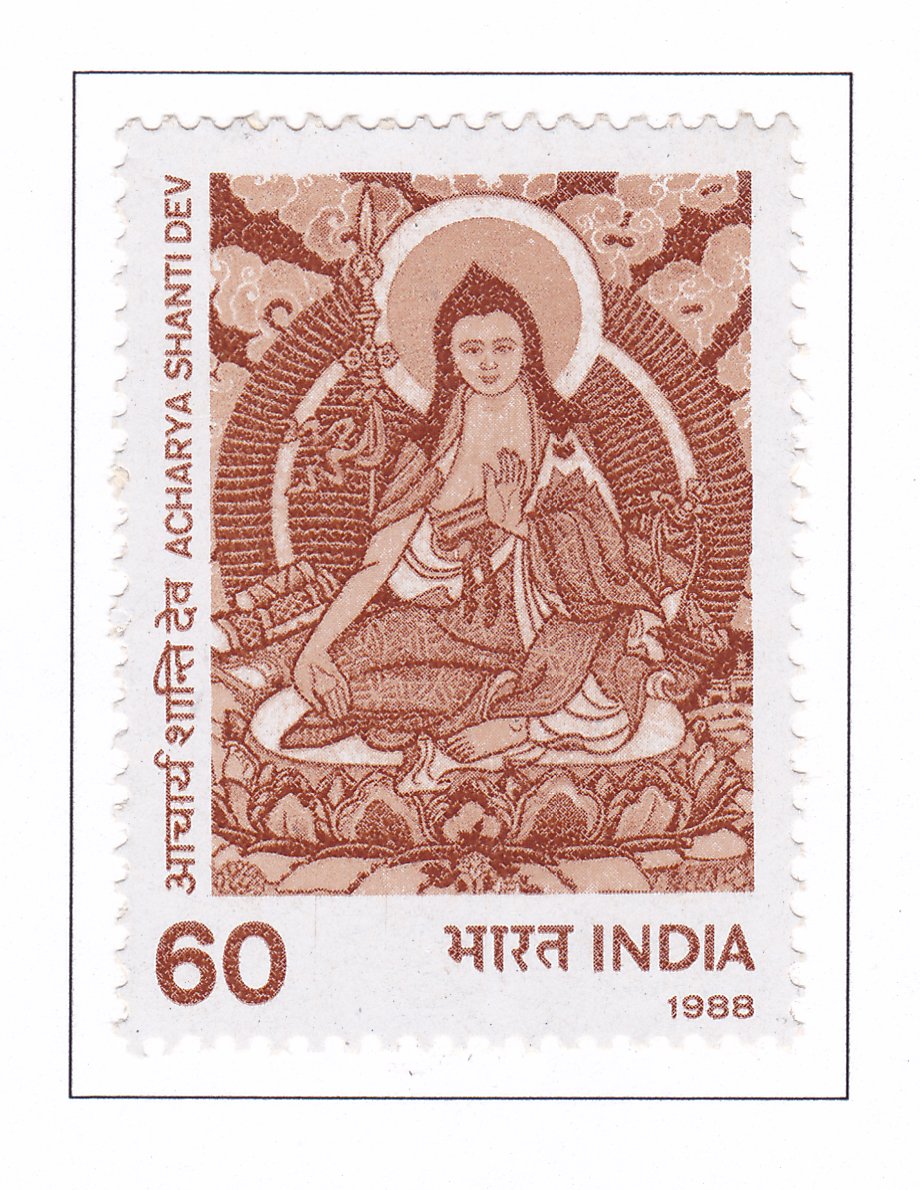Acharya Shanti Dev

Technical Data
| Date of Issue | July 28, 1988 |
|---|---|
| Denomination | 60 p |
| Quantity | 1,000,000 |
| Perforation | comb 13 x 13½ |
| Printer | Security Printing Press, Nashik |
| Watermark | No Watermark |
| Colors | Red Brown |
| Catalog Codes |
Michel IN 1172 Stamp Number IN 1233 Yvert et Tellier IN 984 Stanley Gibbons IN 1323 |
| Themes | Authors | Commemoration | Famous people | Literary People (Poets and Writers) | Literature | Men |
Commemorative Stamp: Acharya Shanti Dev
Design Elements:
- Main Theme: Celebrating the life and contributions of Acharya Shanti Dev, a revered Sanskrit poet, Buddhist scholar, and author of the classic “Bodhicharyavatar.”
- Imagery: Features a portrait of Acharya Shanti Dev, along with symbols representing his literary and philosophical contributions to Mahayana Buddhism.
Biography and Achievements:
- Early Life: Born in 687 A.D. in the royal family of Gujarat, son of King Kushala Varman and Queen Vajrayogini. Originally named Shanti Varman, he was the heir to the throne.
- Spiritual Calling: Before his coronation, he had a visionary dream of Bodhisatva Manjushri, leading him to renounce his royal life and pursue the path of Dharma.
- Education and Literary Work: Traveled to Nalanda, where he studied Buddhist scriptures, mastering Sanskrit and Pali. He began writing poetry and philosophical works, culminating in his masterpiece “Bodhicharyavatar.”
- Bodhicharyavatar: This seminal work describes the stages in the life of a Bodhisatva and the development of Bodhichitta, the Mind of Enlightenment. It has been translated into many languages and is recited daily by millions in Mahayana Buddhist communities.
- Philosophical Contributions: His works, including “Siksha Samuchaya” and “Sutra Samuchaya,” elucidate the Madhyamika system of Buddhist philosophy, initially propagated by Acharya Nagarjuna.
- Debates and Teachings: Known for his debating skills, he defeated many scholars and composed various philosophical texts, becoming a prominent figure in Mahayana Buddhism.
- Social Contributions: Actively worked as a social worker during times of famine in Gujarat, providing food to thousands. He also intervened in conflicts, promoting peace and goodwill.
- Philosophical Realization: Achieved profound spiritual insight, declaring “Everything is like space,” reflecting his deep understanding of Buddhist philosophy.
Legacy:
- Literary and Philosophical Impact: His works, especially “Bodhicharyavatar,” continue to be central to Mahayana Buddhist practice and philosophy.
- Social and Spiritual Influence: Remembered as a saint, scholar, benefactor of the poor, and promoter of peace and harmony.
Example of the Stamp Design:
- Portrait: A respectful and detailed portrait of Acharya Shanti Dev.
- Literary Symbols: Visual elements representing his works, such as scrolls or books with Sanskrit verses.
- Buddhist Imagery: Icons symbolizing Mahayana Buddhism, such as the Bodhisatva Manjushri or Buddhist stupas.
- Social Contribution: Imagery depicting his humanitarian efforts, such as providing food to the needy.
Significance:
- Historical Importance: Honors Acharya Shanti Dev’s significant contributions to Buddhist literature and philosophy.
- Cultural Legacy: Celebrates his enduring impact on Mahayana Buddhism and his role in promoting social welfare and peace.
Description of Designs:
- Portrait Illustration: A detailed and respectful portrait of Acharya Shanti Dev.
- Literary Imagery: Visuals depicting his major works and contributions to Buddhist literature.
- Buddhist Symbols: Elements representing the teachings and philosophy of Mahayana Buddhism.
- Humanitarian Icons: Symbols highlighting his social work and efforts to help the needy.
The first day cover and cancellation design would include introductory lines about Acharya Shanti Dev’s life and contributions, with a line drawing of significant symbols representing his role in Buddhist literature, philosophy, and social welfare.
